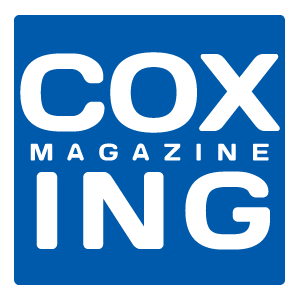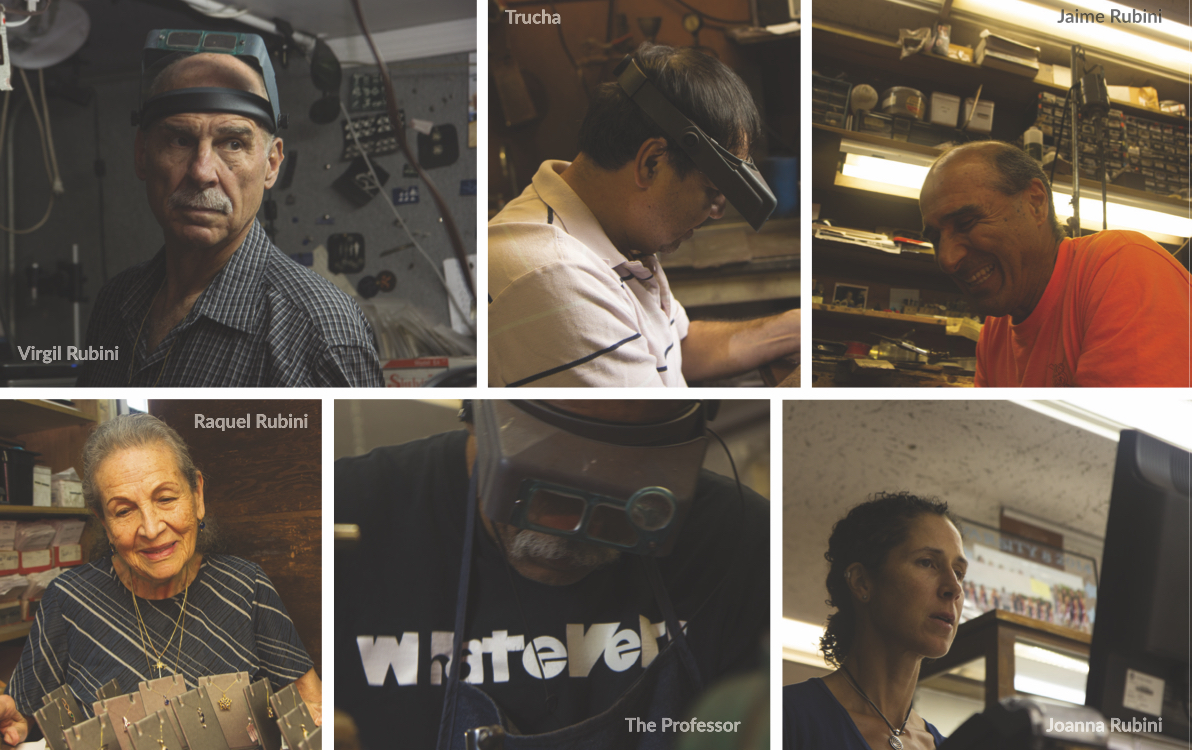Story and Photos by Jen Whiting
Jaime Rubini coaching Alexandria Community Rowing
In order to understand this story, you need to be on the starting line of a race with the water lapping at your boat. The aligner’s voice booms over the speakers. You feel the presence of the wind swirling, bringing your focus inward. As you wait for the starting flag to drop, you reach back into your past and feel the weight of your ambition, the toil of your training and the pull of the finish line flow through your veins, every muscle fiber alert and examined, ready to race.
This is where the story of Rubini Jewelers–the makers of that gorgeous rowing jewelry that has a nearly ubiquitous presence at regattas–began: on the starting line of a race course in Miami, Florida.
Jaime Rubini started rowing as a teenager in Lima, Peru, in the 1960s. His brother was the one who brought him to the Lima Rowing Club and he stayed. “They fed us breakfast,” Rubini told me, as we sat in the back of his studio in historic Alexandria, Virginia, “three pieces of bread and a half gallon of milk with honey. I stayed.”
As Rubini tells me the story of his early rowing, his eldest brother, Virgil, brings me a stool. “He’s always the gentleman,” Rubini says, nodding his head toward Virgil as the handsome older brother returns to his workspace. Rubini, his face strong and reflective of the sun, goes on, “Rowing has always been my right arm, it’s been my life.” He looks up as his hands cradle a belt buckle on his repair bench. “It changed me completely.”
As a young man in Peru, Rubini partnered with Virgil to run a laundry business. After three years of working with his family–in laundry and in their spirits business–he competed in the Pan Am Games for Peru. After that racing experience, he knew he would need to travel to find training partners who would help him hone his rowing skills.
“The boat I really wanted to row was the Pair with Coxswain.” Rubini smiles at me as the words escape his grin. “My coach said, ‘You don’t know how to row that.’ I was cocky, though. I thought I could fake it.” It was then that he knew it was time to head to America, to find training partners and coaches who would help him become the rower he wanted to be.
“I was 20 years old when I arrived in the United States,” he says. Rubini arrived in Miami in 1971, but didn’t find the rowing scene he craved, so he hopped on a Greyhound bus for Los Angeles. “They got me a job,” he says, of the rowers he met in Los Angeles, “but I wanted to row.” Another cross-country bus trip took Rubini to Philadelphia, where he had been told to find Jack Kelly.
“So I went to Philadelphia and I remember it was very strange. I was hitch-hiking and this guy picked me up and asked me, ‘Where are you going?’ I said, ‘Row.’” Rubini smiles again as he looks at me. “I didn’t speak much English.” The story continues as the buckle in Rubini’s hands gets prepped for repair. “He said, ‘Row–where? There’s a big river over there.’ He drove me across the Schuylkill and took me to Boathouse Row. I wasn’t sure which boathouse Jack Kelly was in. Before he let me off, he offered to take me to his house so I had a place to sleep.”
Rubini got a night’s sleep and then made it back to Boathouse Row the next day. He found Vesper Boat Club and was sent to Jack Kelly’s office on Cherry Street. “Kelly was sitting in his office with his feet up on the desk,” Rubini says. The exchange between the two men went like this:
Kelly: What’s Up?
Rubini: Rowing (with some hand motions involved)
Kelly: Where are you from?
Rubini: Peru.
Kelly: Ever sculled before?
Rubini: No.
Kelly: You want to row?
Rubini: Yes!
Kelly: OK. The bed [in Vesper Boat Club] is yours.
And so it began. Rubini moved into the boathouse and began training with the sculling group at Vesper. “I was at Vesper for a couple of years with that group,” he smiles that infectious smile again. “Jack St. Clair, Donny Knecht and Kelly. Vesper was very good to me.” He pauses, rubbing his fingers over the edge of the buckle, as if he needs to know its curve before he takes his torch to it. “And then I met my wife there, and we got married.”
Rubini trained and raced as a sculler on the Schuylkill for three years, then he sustained an injury and, after the birth of his daughter, Joanna, he and his wife moved back to Peru. “I needed to stay off the water for a little while,” he says. After two years of being in business with Virgil, they started collecting Peruvian craft objects, “To do–what do you call it–an import business.” They rented a storefront in Alexandria (Rubini’s brother-in-law had recommended the location). “It was 400 square feet, like a tiny house. We brought in rugs and gourds. We started getting more and more jewelry in the store.” Alexandria proved a good place to have an import store. As their clientele grew, so, too, did the requests for jewelry repairs.
As the repair requests came in, Rubini took a class in jewelry making. “I loved it, I just loved it,” he says. “But if you’re going to repair, you’ve got to be able to make.” This rower-turned-jeweler quickly learned that repairs are really a re-making of the piece. If he was going to be successful at repairing jewelry, he needed to understand how to make it, which metals work with which, how the pieces maintain their integrity, what’s the best way to uncover what a piece of jewelry is made of… all of this captured Rubini’s curiosity. He turned the same focus he’d used in sculling to becoming a jeweler and now, some forty years later, his jewelry represents the sport he so loved as an athlete.
“I started selling rowing jewelry so I could race.” A wry smile spreads across his face. “Masters Nationals was in Miami in 1990 and I wanted to go race–it was one of the first years I got back into racing–and my mother and father and brother were just coming to Miami. I said, ‘I’ll see you there.’ We hadn’t shown any of the jewelry to the public yet. Everyone was pretty excited about it.”
I ask Rubini if anyone else was making rowing jewelry when he started. “I don’t really know,” he says, his voice as relaxed as a good slide on the recovery, “I didn’t really investigate it. I just wanted to race.” He chuckles a bit. “It was my excuse to race.”
The following year, the FISA Masters World Championships were held in Miami and Rubini set-up his first booth. “We’ve seen a lot of growth over the years. The sport has grown tremendously–the growth in the South, the spread into the center of the country–it’s fantastic.”
Without rowing jewelry, the passion for the sport may go unheralded in non-rowing company. A simple silver oar that delicately encircles a woman’s wrist or a tie-pin that is so subtle even the notion of the finish line is quiet behind the question from an onlooker, “Is that an oar?” Rowing jewelry allows the sport to flow into airport lounges, classrooms, cocktail parties and your in-law's dinner table.
In the shop, Virgil creates 3-D models for casts and molds and does most of the metal etching. “The Professor” sits at a buffing station, detailing a custom piece of jewelry that is coming to life under the high-speed polishing cloth.
“Trucha” is in the far back room, preparing molds for the oven and the vacuum casting machine that creates the cast cavities and then draws the precious metals into every nook and cranny of a ring or a pendant or a pin. Once the pieces are cast, he buffs, shapes, cleans and polishes them. It’s slow, painstaking work, but to see a set of crossed oars emerge from his capable hands–and to picture them pinned on a black velvet gown–is mesmerizing.
Rubini’s mother, Raquel, creates the display cases, both for their Alexandria store and for the shows they take to regattas. Joanna, Rubini’s daughter, runs the business, both in Alexandria and on the road. Rubini’s wife, Yolande, travels to regattas, tending the booth and getting to know the rowers her husband and step-daughter compete against (both Rubini and Joanna still row competitively). And, as their reach grows, so, to, does their jewelry. Joanna’s partner is an avid ice hockey player; now Rubini Jewelry makes ice hockey pendants, field hockey jewelry, lacrosse sticks as lapel pins. “It’s all about the blade,” says Rubini.
Rubini coaches at the nearby Alexandria Community Rowing, working with the Masters rowers as well as the high school girls crew. Spending the afternoon in Rubini’s launch is much like spending a morning in his shop: the work seems to happen effortlessly, and the shine on the pieces is distinct. As the high school girls he’s coaching complete their warmup, his coxswain calls, “All eight on the square.” I watch, camera in hand. After ten strokes of all eight athletes rowing on the square, and no respite in sight, I ask Rubini how long they’ll row on the square. “Oh, they’ve got a few minutes here.” I raise my eyebrows at him, showing my surprise. “They don’t know any different,” he says, “they think this is what everyone does for a warm-up.”
The ease with which he calls for changes in his rowers, the confidence he puts in his coxswains, the few words he uses to convey his point, all of these remind me of how gentle he was when he was working with the softest of metals–the buckle he’d turned in his hands as we talked–his torch reshaping the joint that needed to be fixed.
“Virgil’s the technician,” he explains, reminding me of the 3-D image Virgil’s mouse had formed on his computer screen that morning. “I’m a little more eclectic. I do it by hand. I carve the wax. I’m more free-form. I’m a little much looser,” he says, his Peruvian accent as thick as the wind. As we watch the two Eights he’s trailing in the launch as they execute their practice pieces, I don’t know if he’s talking about his jewelry, his coaching or his rowing. In the end, maybe it’s all the same. Maybe it’s all fluid under the torch.
Alexandria Community Rowing practice
A ring awaits buffing, cleaning and polishing











